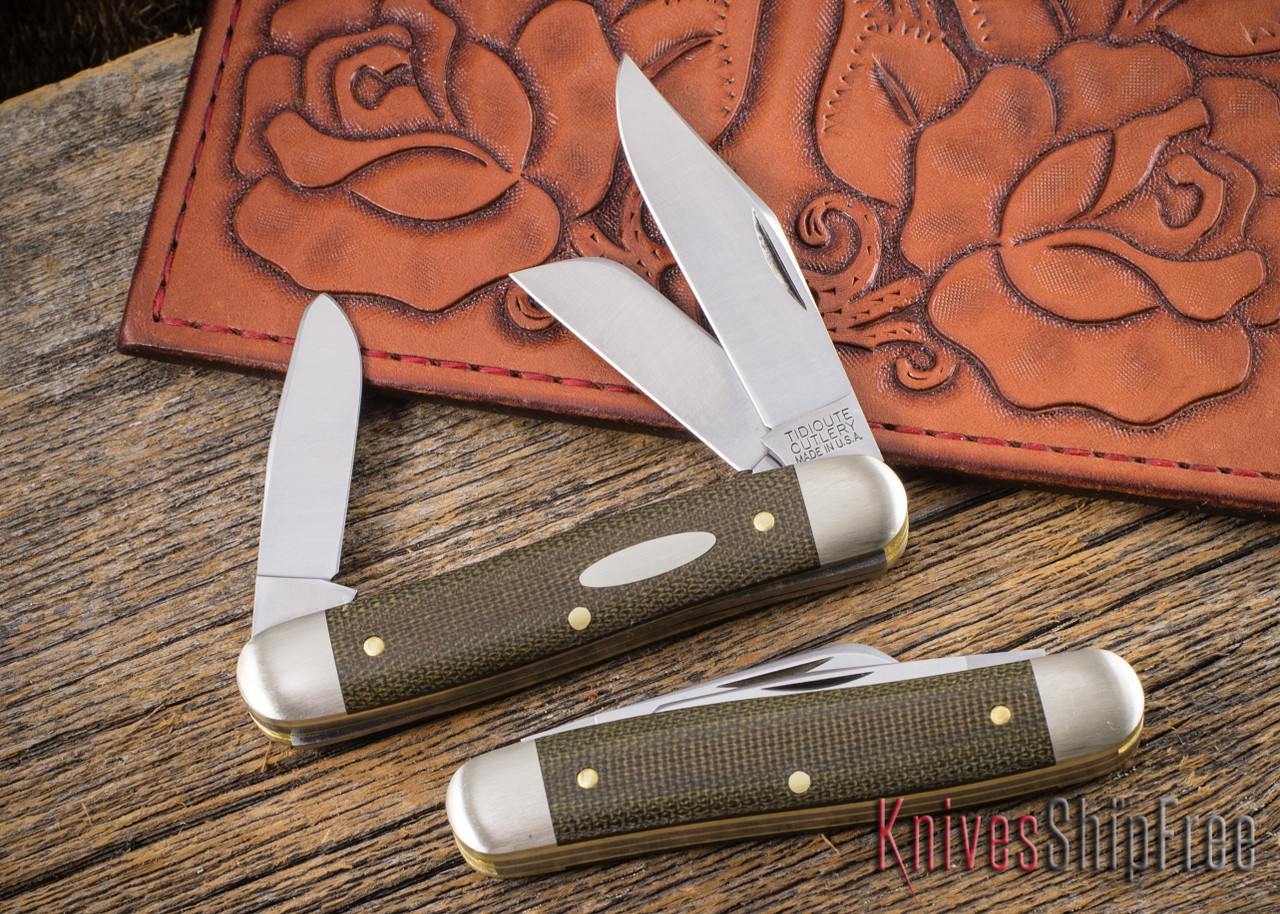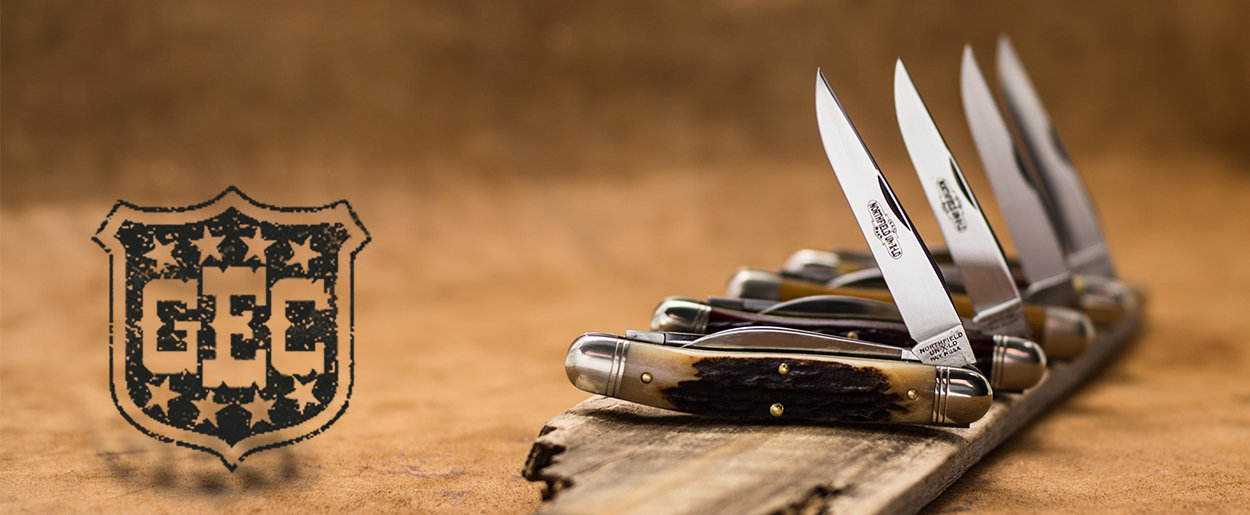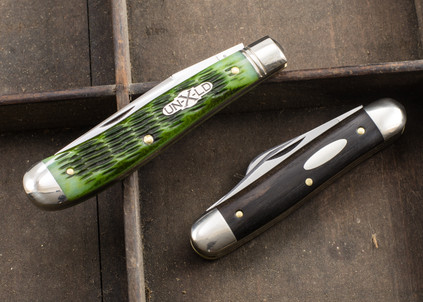About GEC
Owned by Bill Howard, chief designer at Queen Cutlery for many years, Great Eastern Cutlery brings 60 years of industry leadership to its products -- in other words, you can trust these guys to turn out top-quality knives. So if the tang stamp says Tidioute Cutlery, Northfield Un-X-LD, Farm & Field Tool, or Great Eastern Cutlery, rest assured that it's one of the best made-in-USA knives you can buy.
Why does Great Eastern Cutlery use the name "Tidioute" or "Northfield UN-X-LD" on their knives?
Great Eastern Cutlery operates in a part of the United States that carries a rich amount of knife history, especially in the cutlery companies that used to operate there over a century ago. Two of these classic names were revived by GEC in order to carry on their traditional way of producing classic pocket knives.
Tidioute Cutlery: These knives are beautifully made, but they are designed with function and practicality above beauty. The finish and the materials are practical, intended to be a working knife. The blades are satin-finished 1095 carbon steel, and the covers are durable material like cattle bone and ebony wood.
Northfield UN-X-LD: The most premium materials and finishes are reserved for this line. The handle covers feature exotic pieces of genuine stag antler and richly figured woods. The 1095 carbon steel blades are finished to a mirror polish, and the bolsters are finished with finer details such as fluting.
You may also find some GEC models marked under the following:
Great Eastern Cutlery: This self-named line from GEC features 440C stainless steel, the acorn shield emblem, and preferred materials such as elk antler, cattle bone, and hardwoods - all sourced in the U.S.
Farm & Field Tool: These are built solely to be hard-working, chore-tackling knives. The handles are made of extremely durable delrin, micarta, or acrylic. The rest of the knife is an all-steel construction with reinforced pins and 1095 carbon steel blades and backsprings.
Why choose Great Eastern Cutlery?
KnivesShipFree is the largest Great Eastern Cutlery dealer in the world.
We chose to carry GEC knives because they offer some of the highest quality traditional slipjoint pocket knives you can buy. they use top shelf materials, exotic handle materials (covers) and seem to have their finger on the pulse of the pocket knife consumer.
Their patterns are thoroughly traditional in their origin and are actually made the same way they have been made for more than a century.
What does the six-digit number on my GEC knife mean?
One of the cool things about Great Eastern Cutlery is that there's a seemingly endless selection of patterns and blade styles. Keeping track of that many variations can get complicated, though, so GEC came up with a six-digit numbering system.

You'll find this number stamped on the tang of one of the knife's blades (at the base, near the pivot). The first two digits denote the Great Eastern Cutlery pattern number. The next digit identifies the style of the main blade:
- 0 = Wharncliffe
- 1 = Regular Clip
- 2 = Regular Spear
- 3 = Sheep Foot
- 4 = Spey
- 5 = Drop Point/Skinner
- 6 = Sabre Clip
- 7 = Sabre Spear
- 8 = Muskrat Clip
- 9 = Cotton Sampler
The fourth digit of the code indicates the total number of blades, and the final two digits record the year the knife was manufactured.
In the photo above, the number 252208 appears on the tang of the main blade. Breaking the code, we see that this is Great Eastern Cutlery pattern #25, with a "regular spear" main blade and a total of two blades, made in 2008.

Our second example (left) has 725213 stamped on the tang of the smaller blade. That number reveals that this is Great Eastern Cutlery pattern #72, with a "drop point/skinner" main blade and a total of two blades, made in 2013.
This code can be especially helpful if you're a Great Eastern collector, or when you're shopping for a knife similar to one you've seen, or if you own a GEC knife and simply want to confirm exactly what you have.
Where are Great Eastern Cutlery knives made?
Great Eastern Cutlery knives are proudly made in the United States of America. The company is headquartered in Titusville, Pennsylvania.
Is there a way to keep my GEC knife from getting scratched up in my pocket?
Yes, as a matter of fact, there is -- it's called a pocketslip.
We know that when you invest in a Great Eastern Cutlery knife, you want to protect it. Our pocketslips protect your knife from keys, loose change and debris. More important, it distributes the weight of the knife in your pocket.
That may sound silly -- after all, a knife doesn't weigh that much -- but trust us, it's a big deal. You won't realize what a difference it makes 'til you try it.
The beauty of a pocketslip is its simplicity. It's a leather envelope -- drop your knife inside, slide it into your pocket and it disappears. When you need your knife, a quick squeeze of the sides and your knife is delivered into your hand.
What's the best way to sharpen my Great Eastern Cutlery knife?
Your GEC knife has a v-bevel which means a flat sharpening medium like a DMT diamond stone setup or the KME Sharpening System is going to be a perfect solution. GEC's steel is expertly heat treated so that it will take a fine edge the way a pocket knife is supposed to.
I'm having a hard time opening my pocket knife -- any tips?
It's true that some slipjoint pocketknives have a harder "pull" than others. Not everyone gets the hang of it right away.
Remember, too, that all folding knives have a natural break-in period and will become friendlier after time and use.
Beyond that, we'd like to tell you that we have a super-secret trick to make it easy, but the best advice we've found on the subject comes from almost a century ago.

(from The Book of Camp-Lore and Woodcraft by Dan Beard, 1920)
What's the best way to clean a really dirty slipjoint pocket knife?
It happens to most of us at some point -- one of our favorite slipjoint pocketknives gets really gunked-up.
Maybe it got caked with mud somehow. Maybe we dropped it in the yard and it got rained on before we found it. Maybe we used it on a hunting trip and failed to clean it up afterward.
However it happened, relax -- it's not difficult to bring a gummy pocketknife back to life. Here's how.
- Fill a bowl with hot water and mild dishwashing soap.
- Open all blades of the knife and dunk it in the soapy water. Swish the knife around and (carefully) move the blades to work the solution into the pivots and backsprings.
- After a minute or so, take the knife out of the soapy water and hold it under running hot water. Make sure to rinse away all of the soap residue.
- Right away, dry the knife thoroughly -- and we mean right away and thoroughly. Use canned compressed air and a soft cloth (not paper towels or tissues). Be sure to move the blades back and forth to work trapped moisture out of the pivots and backsprings.
- After you're sure that the knife is completely dry, apply your preferred lubricant to the pivots. (We like Benchmade BlueLube.) You also may want to apply a small amount of lube to the backsprings and liners, inside the knife.
- Open and close the blades a few times to work the lube into the pivots and between the backsprings and liners. This also will help displace remaining moisture.
- Keep an eye on the knife over the following few days and weeks to make sure the blades continue to move freely. Reapply lube as necessary.
Here are a few more tips that may help.
- Don't let the knife soak for any length of time in the soapy water (or any other cleaning solution). Some scales (handle materials) may darken and others, like wood, will swell.
- One of the best tools we've found for cleaning tight spots and crevices is a wooden toothpick. To turn it into a tool for drying the knife, wrap the tip in a piece of soft cloth. (A cotton swab will work, too, but be careful not to snag it in the joints and sharp edges.)
- If you're a fan of WD-40, be careful -- although it'll do a great job of displacing moisture trapped in the pivots, petroleum distillates like WD-40 can stain or permanently damage handle materials. (Celluloid comes to mind.) If you do use it, be sure to use the snorkel (that little plastic tube) and aim it precisely at the pivots. And never, ever soak your slipjoint in petroleum distillates.
That's it. Take your time to do this right and you'll be amazed at how effective it is.
Taking the mystery out of patina, rust & 'stainless' steel
Here at KnivesShipFree.com, among the questions we’re asked most often are, “Why did the blade of my new knife turn gray the first time I used it?” and “Why is there rust on my stainless-steel knife?”
For the sake of simplicity, we can say that knife blades are made from either stainless steel or carbon steel. The fundamental difference between the two is in the amount of chromium added to the iron-based material -- a steel with at least 13% chromium content generally is considered "stainless."
Carbon steel -- like the 1095 used by Great Eastern Cutlery and the A2 used by Bark River Knives, to name two -- naturally is more prone to something called “oxidation,” the most damaging form of which is rust. Another type of oxidation, the kind that darkens a shiny new knife blade, commonly is called “patina” -- and it’s actually a good thing.
Before the advent of mass-produced stainless-steel knives, virtually all blades were carbon steel. When a knife developed a patina of gray or even black, the change in color simply was an indication of use. Some still consider patina a sign of character – both of the tool and the owner.
Most important, patina forms a sort of protective barrier to more sinister oxidation. It tends to fill-in microscopic imperfections in the surface of the steel, making it more difficult for rust to take hold. In fact, many savvy (and impatient) knife owners intentionally “force” a patina on their knives by cutting onions, potatoes, pineapples or strawberries.
Of course, it’s possible to remove patina with fine metal polish. The question is, why would you want to?
With that understanding, then, let’s talk stainless. One of the most common misconceptions among knife owners is that “stainless steel” means “rustproof steel.”
It doesn’t -- rust-resistant, maybe, but not rustproof. Although nasty orange oxidation has to work harder to develop on stainless steel, it’ll show up eventually if a knife isn’t cared for properly.
Allowing food residue, blood or moisture to sit on the blade is just begging for rust (and permanent damage), so the simple practice of cleaning a knife after each use -- and checking that it’s dry before sheathing it -- is common-sense maintenance. It’s also a good idea to wipe it down regularly with a light oil, but make sure that it’s a non-detergent oil and, if you use your knife to cut food, that it’s non-toxic.
Carbon steel or stainless, no matter what you paid, your knife is an investment. You don’t have to pamper it to make it last a lifetime -- all it takes is an ounce of prevention.






